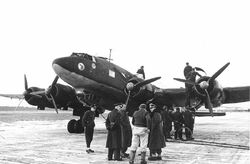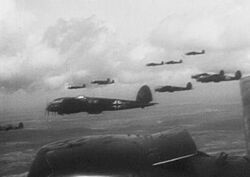The Luftwaffe (German for Air Weapon) was Nazi Germany's airforce that was unveiled in 1935 and later demilitarized in 1945.
Overview[]
At the beginning of the war, the Luftwaffe was one of the most powerful, advanced, and experienced airforces on the planet. The main fighter aircraft of the Luftwaffe was the Messerschmitt Bf 109. The Luftwaffe also included planes such as the Ju 87 Dive Bomber, Heinkel He 111, Dornier Do 335, Focke Wulf Fw 190, Dornier Do 17, Junkers Ju 88, Henschel Hs 129, Heinkel He 177 and the Junkers Ju 52. The Luftwaffe became very effective when used in German tactics such as Blitzkrieg. This is why for the beginning of World War II the Luftwaffe ruled the skies. However the Luftwaffe later lost The Battle of Britain which then marked a steady decline of effectiveness by the Luftwaffe, especially after waves of bombers surrounding by support fighters flew over Nazi Germany towards the end of the war. Even so, the Luftwaffe was used throughout World War II in campaigns such as the Eastern Front.

History[]
Before the War[]
The initial foundations of the Luftwaffe were actually put in place in 1920 when General Hans von Seeckt, Chief of Army Command at the Defense Ministry, secreted a small group or regular officers into the various sections of the Ministry which were clandestinely dealing wholly and exclusively with aviation matters.[1]
The exclusion of a clause in the Treaty of Versailles, prohibiting the mass production of civil aircraft, allowed the Germans to carry out an unprecedented expansion of civil aviation, resulting in the unhindered development of aircraft and training of aircrews.[1] This led in 1926 to the founding of the German state airline Deutsche Lufthansa, resulting in the development of airfields, flying instruments and radio navigation aids.[2]
Operational units of the Luftwaffe were initially shared out between four Luftflotten (Air fleets):
- Luftflotte 1, headquartered in Berlin under the command of General de Fliger Albert Kesselring, responsible for units in North East Germany,
- Luftflotte 2, headquartered in Brunswick under the command of General de Fliger Helmut Felmy, responsible for units in North West Germany,
- Luftflotte 3, headquartered in Munich under the command of General de Fliger Hugo Sperrle, responsible for units in South West Germany, and
- Luftflotte 4, headquartered in Vienna under the command of General de Fliger Alexander Lohr, responsible for units in South East Germany, Austria and Czechoslovskia.[3]
The Phoney War[]
On 2 September, 1939, the Luftwaffe's front line units possessed 3,659 serviceable aircraft, of which less that half (1,550 to 1,600) were earmarked for the attack on Poland.[N 1]. These were assigned to the four Luftflotten (Air fleets) and the Lehrdivision,[5]
Blitzkrieg[]
The Battle of Britain[]
The Luftwaffe Quartermaster report for 17 August 1940 stated that front line units possessed 3,157 front line aircraft
The Blitz[]
North Africa and The Mediterranean[]
Following the Italian Armistice with the Allies in September 1943, the Luftwaffe seized hundreds of Italian aircraft. By March 1944, many of these had been passed to the Aeronautica Nazionale Repubblicana. [6]
The Russian Front[]
Preparation[]

Luftwaffe aircraft in flight.
Luftwaffe preparations for the eventual Invasion of Russia were started in October 1940, with Luftwaffe works units and construction material being moved to newly captured Polish territory during the remainder of the year. Construction of air bases and fuel dumps, together with the deployment of flak units, were well under way by early spring 1941, followed by preparations to receive combat units started in April and May. By mid June, this had resulted in the transfer of 2,770 out of 4,300 front line aircraft, comprising 775 bombers, 310 Stukas, 830 Bf 109s, 90 Bf 110s and 765 reconnaissance and coastal aircraft.[7]
D-Day and afterwards[]
The Luftwaffe Quartermaster report for 31 May 1944, the last before the D-Day landings, showed that front line units possessed 4,928 serviceable aircraft. [8] On the first day of the invasion, the Luftwaffe mounted 100 fighter sorties and 175 bomber sorties, compared to the 14,674 flown by the Allies, with Luftwaffe aircraft being conspicuous over the beaches by their absence.[9]
Codewords[]
The Luftwaffe used a number of standard codewords in their radio transmissions.
| Codeword | Translation | Actual meaning |
|---|---|---|
| Kirchturm | Church tower | Own height in hundreds of metres |
| Hanny | Jhonny or 'Bloke' | Enemy height |
| Caruso | - | Course |
| Zirkus uber | Circus over | Assemble at... |
| Gartenraum | Garden room | Airfield |
| Horrido | - | I have shot down enemy aircraft |
| Ente | Duck | Range from enemy aircraft |
| Bodo | - | Unit headquarters or own base |
| Orkan | - | Enemy speed |
| Tuba | - | Bearing |
| Pauke-Pauke | - | Attack! |
| Viktor | - | Understood |
| Ich beruhre | I touch | I have seen the target |
| Otto-Otto | - | Target in searchlight |
| Normaluhr in | Normal time | Wait at... |
| Ich habe Durst | I am thirsty | I am short of petrol |
| Radfahrer | Cyclist | Own single engine aircraft |
| Mobelwagen | Furniture Van | Own twin engine aircraft |
| Dicke Mobelwagen | Bulky Furniture van | Own three engine aircraft |
| Feindlich Jager | - | Enemy fighters |
| Autos | Cars | Enemy twin engine aircraft |
| Dicke Autos | Bulky Cars | Enemy three engine aircraft |
| Freie Bahn | Free road | Enemy fighters breaking formation |
| Donnerkeil | Thunderbolt | Night attack |
| Stacheldraht | Barbed wire | Flying within certain heights forbidden |
| Objekt | Object | Designated object being defended |
| Mauerblume | Wallflower | Contact with the enemy |
| Spielbeginn | Start of the game | Enemy formation recognised at (followed by place name) |
| Halbzeit | Half time | Abandoning engagement |
| Ich suche | I am looking | I haven't seen, or have lost, the target |
| Gehen Sie ins Vorzimmer | Go into the anteroom | ...Wait |
| Konkurrenz | Competition | Danger warning |
| Weiss | White | Fighter operating with searchlights |
| Schwartz | Black | Fighter operating without searchlights |
References[]
Sources[]
- ↑ 1.0 1.1 Wood, Tony and Bill Gunston. Hitler's Luftwaffe. Salamander Books. 1997. ISBN 0 86101 935 0 Page 8
- ↑ Wood, Tony and Bill Gunston. 1997. Page 9
- ↑ Price, Alfred. The Luftwaffe Data Book. Greenhill Books. 1997. ISBN 1 85367 293 9 Page 14
- ↑ Wood, Tony and Bill Gunston. 1997. Page 14
- ↑ Price, Alfred. 1997. Page 20
- ↑ Neulen, Hans Werner. In the Skies of Europe - Air Forces allied to the Luftwaffe 1939-1945. The Crowood Press. 2000. ISBN 1-86126-326-0 Page 75
- ↑ Wood, Tony and Bill Gunston. 1997. Page 40
- ↑ Price, Alfred. 1997. Page 92
- ↑ Wood, Tony and Bill Gunston. Page 108
- ↑ Townsend Bickers, Richard. The Battle of Britain - 50th Anniversary. Salamander Books. 1990. CN 1338 Page 60.
